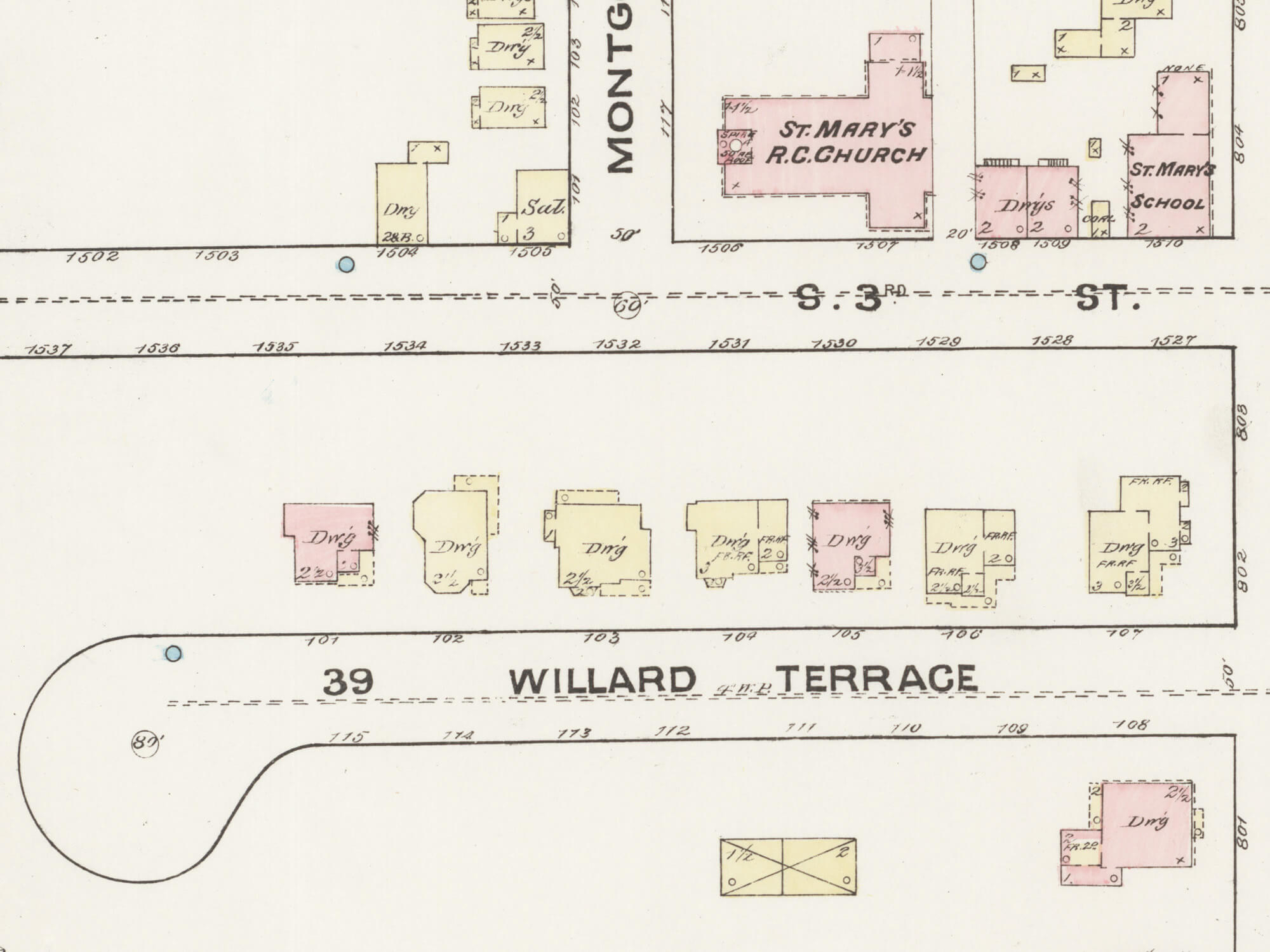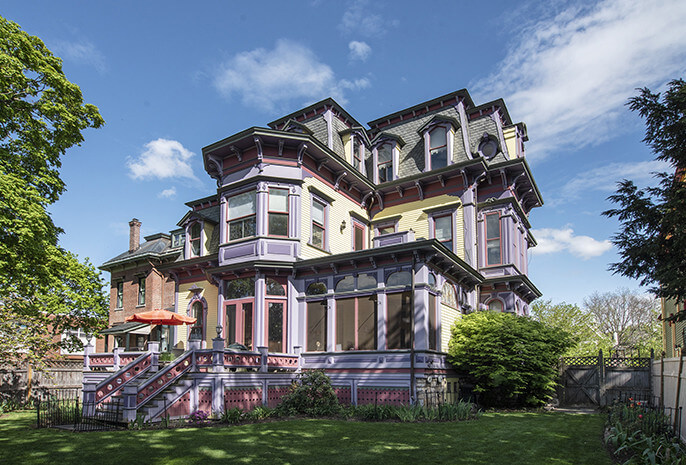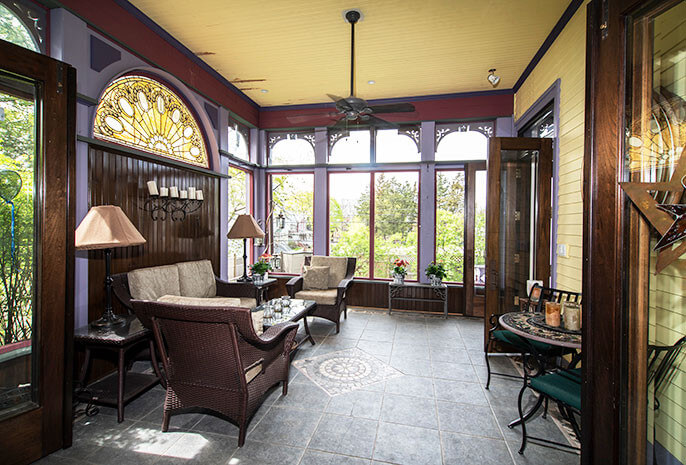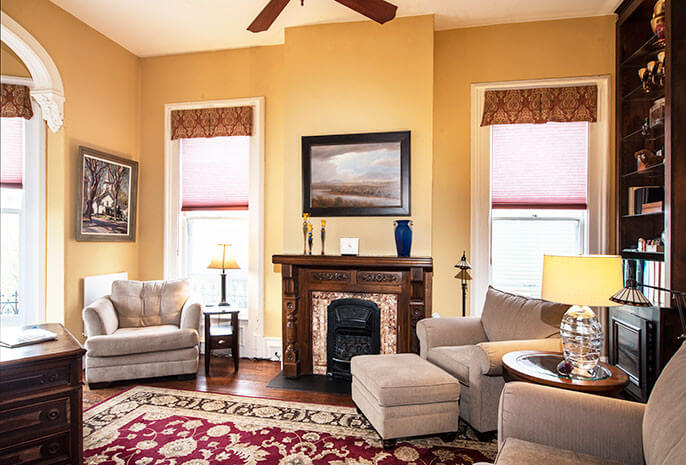Exuberant Hudson Second Empire Confection by Architect G. B. Croff, Yours for $1.45 Million
It may look like just another residential street among the many architecturally scenic stretches in Hudson, but Willard Place was designed as a small residential enclave in the early 1870s.

It may look like just another residential street among the many architecturally scenic stretches in Hudson, but Willard Place was designed as a small residential enclave in the early 1870s.
One of the picture-perfect grand mansions, designed by an architect well-known in his day, is on the market at 4 Willard Place.

The little development of Willard Place was made possible in 1872 with the sale the former Willard property at the corner of Third and Allen streets. The developers William I. Traver & Son announced plans for a refined residential enclave with a circular carriageway, park and sidewalks on the new street. The houses, the Hudson Daily Star reported in April of that year, would have a splendid view of the Catskill Mountains and would be “neat and attractive in appearance” and would surely be bought by “responsible and respectable parties.”
Construction started that year and by 1874 several houses were already completed, with more on the way. At least one of the new lot owners turned to a Saratoga Springs architect well known for his house plans, Gilbert Bostwick Croff.

Popularly known as G. B. Croff, the architect was an enthusiastic proponent of the Second Empire style and specialized in grand hotels and dwellings. In addition to designing buildings for clients, Croff sold plans for houses and published a number of pattern books, including “Model Suburban Architecture” and “Original Designs for Front Entrance Doors.”
Croff supplied plans to lawyer A. Frank B. Chace for his new family home at 4 Willard Place. Work on the house began in the fall of 1874, with the Hudson Daily Star reporting in November that the new Chace house was to be a “handsome new dwelling.”

While Croff is not identified in the article as the architect, the tell-tale evidence appeared in print in 1875. That year Croff published “Progressive American Architecture,” a book filled with detailed elevations and plans for houses, banks, schools and office buildings of “every character and class.” Within the first few pages of the publication are an elevation and first floor plan for the Chase home, identical to 4 Willard Place, identified as a “design for residence executed at Hudson N.Y.”
Since some homeowners simply purchased plans from Croff, it was unclear just how much he was involved with the construction of 4 Willard Place until some new evidence emerged. A fantastic trove of original contracts, bills, receipts and letters in the collection of Avery Drawings and Archives at Columbia University documents the construction of the Chace house. While there are some gaps in the material there is enough to show that Croff corresponded with Chase throughout the building process and visited the construction site multiple times.

The paper trail at Avery includes a draft contract of more than a dozen pages showing that negotiations between Chace and Croff began in June of 1874. By October a builder had been selected; Michael Morris of Rheinbeck was chosen to construct the Croff-designed house for $8,500. Chace received at least one other bid for the project, but with that bid coming in at $10,265 perhaps Chace simply chose the less expensive builder.
The draft contract between Chace and Croff specifies every feature of construction, from the balloon frame to the basement bathroom for servants. Letters from Croff to Chace and to subcontractors show that Croff monitored construction progress to ensure the house was completed to specifications or adjusted to fit Chace’s preferences. In at least one instance Chase was assured that the sliding doors would be built according to his preference for three panels on each door.

By May 1875, bills for final payment of plaster details and other work appear in the Avery collection and it is believed that the house was completed by late summer. New York State census records taken in June of 1875 show the Chace family still in residence elsewhere in Hudson. By the time of the 1880 Federal census, Frank and Mary Chace were settled into 4 Willard Place with their three sons, Frank’s mother and one servant.
Their neighbors on Willard Place included several other lawyers, including Herman Esselstyne who lived at 5 Willard Place. Believed to be another Croff design, 5 Willard Place was constructed by builder E. Denegar beginning in the spring of 1875, according to the Hudson Daily Star.

Number 4 Willard Place stayed in Chace family hands until the early 20th century. Mary died in 1904 and Frank in 1908; the house was listed for sale by their sons, all lawyers, in 1910. They either changed their minds or the house didn’t sell because local newspaper stories list son William Wallace Chace as a resident of the house until at least 1916.
The grand mansion had a number of residents after the Chace family, but one who offered the house a sheen of glamour was young resident Ellen Allardice who moved into 4 Willard Place with her family in the 1930s. In 1939, movie stars Fred MacMurray and Alice Faye were in the Hudson area filming “Little Old New York,” a dramatization of the life of steamboat inventor Robert Fulton. Ellen and some fellow high school students apparently headed to the set to get work as extras in the film. Ellen spent three days as an extra, and her fresh-faced good looks caught the eye of the director Henry King, a story that was breathlessly reported in local papers like The Knickbocker News. Ultimately, Ellen decided to finish high school rather than pursuing Hollywood.

After graduation, she headed to New York and became a model with the John Powers agency. She appeared in toothpaste and deodorant ads and was named “Ideal American Blond for 1941” as part of a Coty cosmetics promotion. During WWII she appeared as a wartime bride on the cover of Life magazine and in numerous patriotic themed photo shoots. Local newspapers eagerly kept track of the progress of the hometown girl, keeping 4 Willard Place in the news.
Despite multiple owners and the passage of time, 4 Willard Place has managed to survive fairly intact. Eight houses were originally built on the private street between 1872 and 1892. Of those homes, 1 and 2 Willard Place were demolished in the 20th century and 5 Willard was dramatically altered in 1941 after a fire claimed its upper stories.

The upper stories of 4 Willard Place are fantastically intact. Other than the cresting, which once would have graced the rooftop and chimneys depicted in the original elevation, it appears that most of the riot of detail designed by Croff is in place. There’s the dramatically narrow tower, a heavy bracketed cornice, bay windows, dormers and a plethora of ornamental window surrounds.

According to the listing, the most recent interior renovation was in 2005 when amenities like heated floors, a gym and wine cellar were added. There’s still plenty of Croff’s original interior details, particularly in the grand spaces of the first floor.

There aren’t any floorplans included in the listing but from the photos, it appears the arrangement of rooms in Croff’s plan — hall, parlor, reception room, dining room — have survived with the noted addition of a modern kitchen.

In addition to marble mantels and wood floors, the house has some wonderful surviving plasterwork. The draft contract at Avery Drawings and Archives shows that Croff intended the hall, reception and dining rooms to each have arches with plaster keystones. The supplier of the ornamental plaster was Henry Berger. Based in the city, Berger’s ads of the time promised “country orders carefully packed and shipped.” For this house, his final bill included eight sets of keystones for the interior arches at a total cost of $24.

The original pantry may have been sacrificed for the addition of a kitchen with necessary modern amenities.

There are a total of five bedrooms in the house. The master suite has some plaster details, stained glass and an attached study. None of the listing photos show closed pocket doors, so it is difficult to tell if Mr. Chaces’ preferred style of door survives.

The house has a total of six fireplaces and according to the listing they are in working condition.

The house has seven bathrooms, although the listing doesn’t make it clear how many are full versus half baths.

Downstairs there doesn’t seem to be any sign in the photos of the modest bathroom for servants. Instead, it has been kitted out with a gym, wine cellar and laundry room.

There’s green space out front and a backyard, and plenty of porch space for relaxing. If you want to stroll the streets of downtown Hudson, it isn’t far. Just saunter about four blocks and you hit Warren Street with its shops, restaurants and entertainment venues like Hudson Hall, the restored former Hudson Opera House built in 1855.
The house is listed for $1.45 million by Pamela Belfor of Gary DiMauro Real Estate.








Related Stories
- A Pattern Book-Perfect Second Empire in Rhinebeck Asks $1.695 Million
- This Picturesque Former Chapel Comes With a View of the Tappan Zee
- Find Artistic Inspiration at the Country Cottage of a 19th Century Portrait Painter, Yours for $725K
Email tips@brownstoner.com with further comments, questions or tips. Follow Brownstoner on Twitter and Instagram, and like us on Facebook.





What's Your Take? Leave a Comment